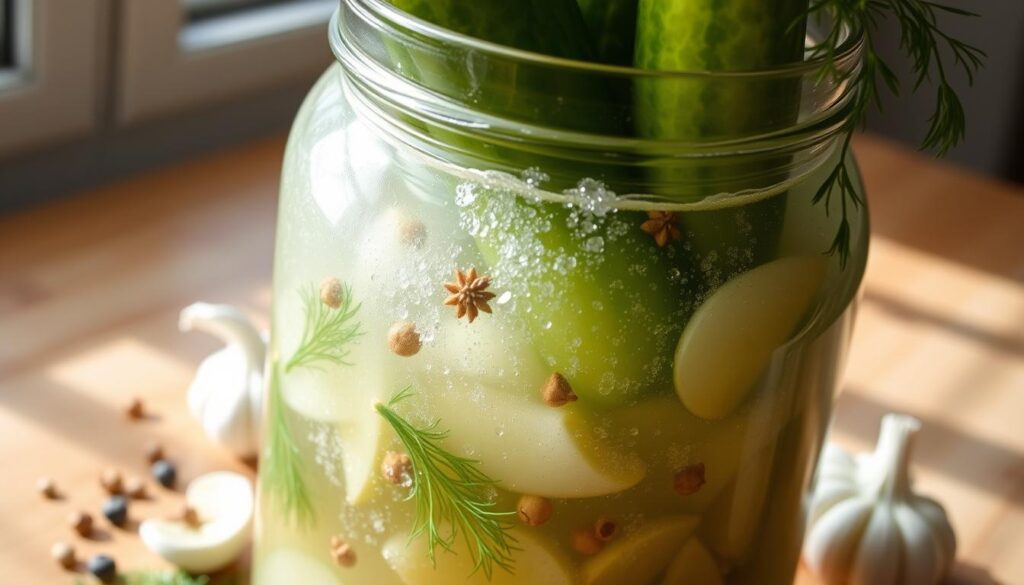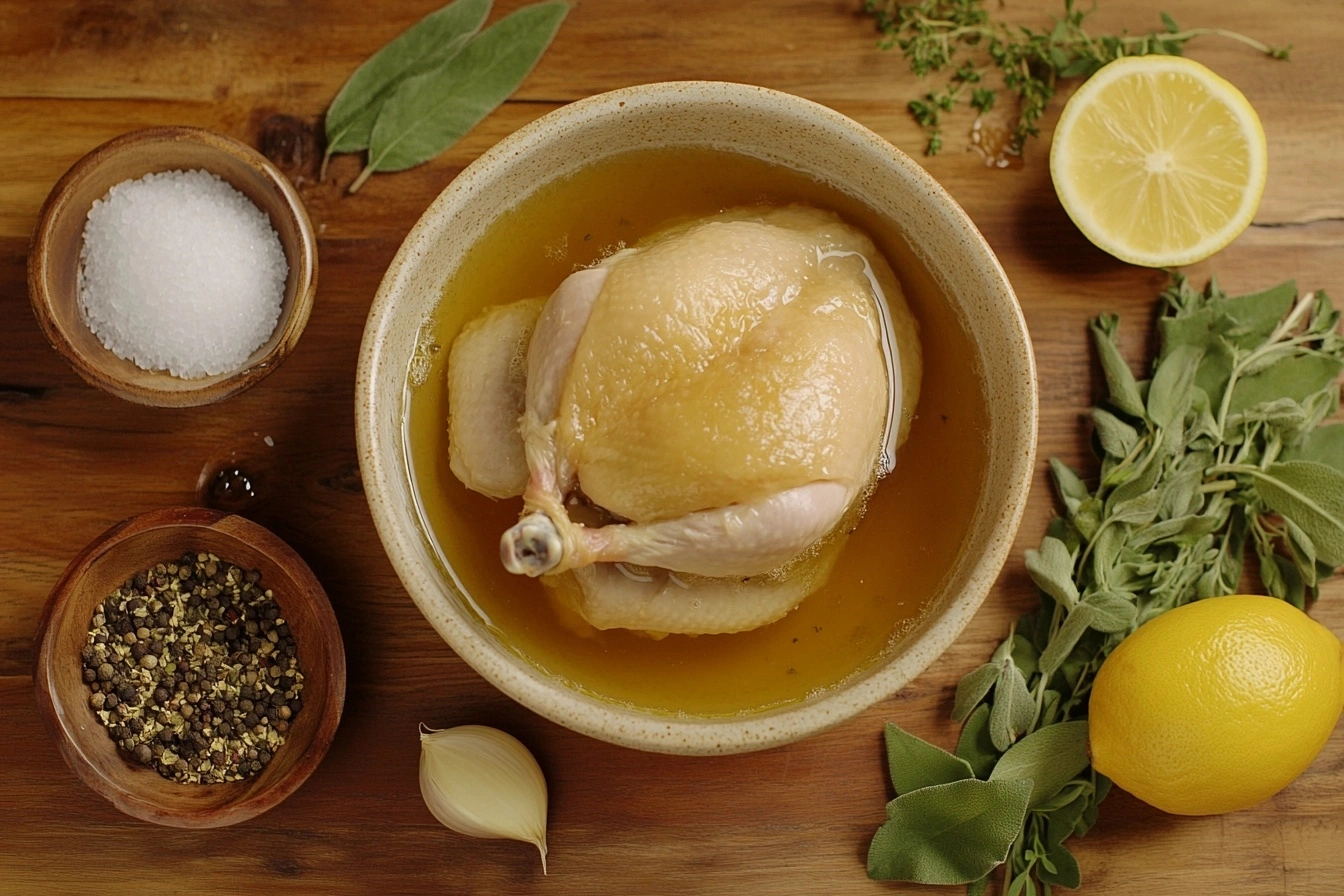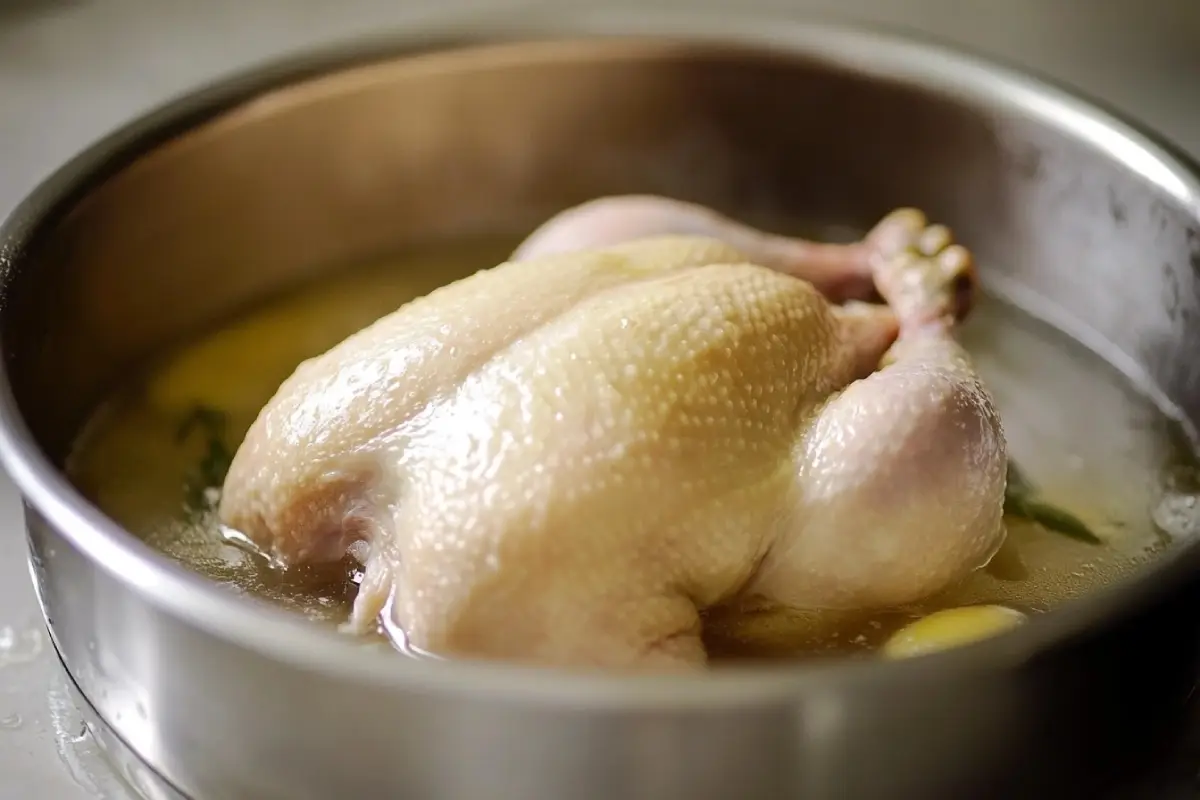Many people wonder if they should add sugar to their brine. Brining is a method to soak meat or poultry in salt water. It’s known to boost flavor and texture. Sugar isn’t a must-have in brine, but it can add some benefits. This guide will cover sugar’s role in brine, its advantages, and the different sugars you can use.
Key Takeaways
- Brining is the process of soaking meat or poultry in a salt-water solution to enhance flavor and improve texture.
- Adding sugar to the brine can provide additional benefits, such as improved flavor and better texture.
- Different types of sugar, such as white sugar, brown sugar, or honey, can be used in the brining process.
- Factors to consider when brining with sugar include the type of meat and the brining time.
- Alternatives to sugar, such as molasses or maple syrup, can also be used in the brining process.
What is Brining?
Brining is a basic cooking method. It involves soaking meat, poultry, or seafood in saltwater before cooking. This simple step makes the food juicier, tastier, and tenderer.
The Basics of Brining
The brining process is easy. First, a saltwater mix is made, sometimes with sugar, herbs, and spices for extra flavor. Then, the food is fully covered in this brine for a few hours or overnight. This lets the brine soak into the food, keeping it moist and adding flavor.
Benefits of Brining
Brining offers many benefits. It makes food moist and juicy by preventing it from drying out. It also boosts the flavor, adding a nice balance of salt, sweetness, and aromas. Plus, it tenderizes tough meat, making meals more enjoyable.

“Brining is a simple yet powerful technique that can transform ordinary ingredients into extraordinary culinary creations.”
Do I Need to Put Sugar in Brine?
Many people wonder if they should add sugar to their brine. The answer is simple: no, you don’t have to. Brining works well without sugar too.
But, sugar can make your brine better. It can make the meat or poultry taste and feel more delicious. This makes the final product more enjoyable to eat.
Whether you add sugar or not, brining is a great way to make your meats juicier. It’s all about what you prefer and what you want your food to taste like.
“Brining is a simple yet powerful technique that can transform the texture and flavor of meats, poultry, and seafood.”
Next, we’ll look at the benefits of sugar in brine. We’ll see how it can improve the taste and texture of your food.

Advantages of Adding Sugar to Brine
Adding sugar to your brine can make a big difference. It can make the food taste better and more appealing. Sugar also helps the food stay juicy and tender.
Improved Flavor
Sugar in the brine balances out the salt and acid. This creates a flavor that’s more enjoyable. The sweetness from sugar adds depth to the taste.
Better Texture
Sugar in the brine also improves the food’s texture. It makes the meat or poultry juicier and more tender. This is especially good for tougher cuts of meat.
In short, adding sugar to brine has many benefits. It improves the flavor and texture of the food. By finding the right balance, your brined dishes will taste and feel better.
“The key to a successful brine is finding the right balance of flavors, and sugar can play a crucial role in that equation.”
Different Types of Sugar for Brining
Choosing the right sugar for brining is key. The type of sugar you pick can change how your dish tastes and feels.
Here are some common types of sugar for brining:
- White Granulated Sugar – This is the most basic and widely used option. It dissolves easily in the brine and adds a subtle sweetness.
- Brown Sugar – Brown sugar is made by adding molasses back to white sugar. It provides a richer, more caramelized flavor to the brine.
- Honey – Honey is a natural sweetener that can add depth and complexity to your brine. It’s especially well-suited for poultry and pork.
- Maple Syrup – This versatile ingredient can infuse your brine with a delightful, slightly smoky maple flavor. It pairs wonderfully with meats like turkey or ham.
Choosing the right type of sugar for brining can change your dish’s flavor. Try different sugars to find the best match for your recipes.
“The right sugar for brining can make all the difference in elevating the taste and texture of your brined dishes.”
Brining Recipes with and without Sugar
Do you like savory or sweet flavors? There’s a brining recipe for you. Brining makes meat or poultry moist, tender, and flavorful. Some recipes use sugar, while others don’t.
Savory Brine Recipes
Savory brines mix herbs, spices, and other tasty ingredients. They give your meats and poultry bold, delicious flavors. Here are some tasty savory brine recipes:
- Garlic and Herb Brine
- Rosemary and Black Pepper Brine
- Citrus and Thyme Brine
Sweet Brine Recipes
Sweet brines use sugar, honey, or maple syrup. They add a sweet touch to your dishes. Here are some yummy sweet brine recipes:
- Brown Sugar and Cinnamon Brine
- Honey and Lemon Brine
- Maple and Mustard Brine
Both savory and sweet brines can make your meats and poultry taste better. Try different ingredients to find your favorite brine.
| Savory Brine Recipes | Sweet Brine Recipes |
|---|---|
| Garlic and Herb Brine | Brown Sugar and Cinnamon Brine |
| Rosemary and Black Pepper Brine | Honey and Lemon Brine |
| Citrus and Thyme Brine | Maple and Mustard Brine |
“Brining is an easy way to add flavor and moisture to your meats and poultry. Experiment with different recipes to find your perfect match!”
Factors to Consider When Brining with Sugar
Brining meat with sugar involves a few important considerations. The type of meat and how long you brine it can greatly affect the sugar’s impact. Knowing these factors can help you get the best flavor and texture from a sugar brine.
Meat Type
Various meats react differently to sugar in the brine. Research shows sugar takes time to penetrate meat. This makes sugar brines great for enhancing browning and caramelization of thinner cuts.
For sugar-cured bacon, longer brining times are best. This allows the sugar to fully infuse the meat.
Brining Time
- The brining time affects how sugar interacts with the meat.
- Longer brining times let sugar penetrate deeper, enhancing sweetness and caramelization.
- Shorter brining times result in a milder sugar effect, mainly on the meat’s surface.
| Brining Time | Sugar Penetration | Flavor Impact |
|---|---|---|
| Longer | Deeper | More pronounced sweetness and caramelization |
| Shorter | Shallow | Subtle sugar influence on the surface |
Understanding these factors helps you use sugar wisely in brining. This ensures your dish has the flavor and texture you want.
Alternatives to Sugar in Brine
Looking for a way to avoid sugar in your brine? There are many options that can add sweetness and unique flavors. These alternatives don’t rely on traditional sugar.
Honey is a great choice. It adds sweetness and brings a floral or fruity taste to your brine. It’s perfect for brining meats, fish, or veggies.
Maple syrup is another excellent option. It gives a rich, caramelized flavor that goes well with many foods. Maple syrup works in both savory and sweet brines.
Molasses offers a deep, robust sweetness. It’s especially good with meats like pork or beef. It adds a complex flavor to your dish.
Fruit juices like apple, pineapple, or cranberry can also sweeten your brine. They add sweetness and unique flavors that enhance your brined items.
- Honey
- Maple syrup
- Molasses
- Fruit juices (apple, pineapple, cranberry)
Try these alternatives to sugar in your brine. You’ll find they add rich, nuanced flavors to your dishes.
Tips for Successful Brining
To brine successfully, whether with or without sugar, focus on a few key points. First, make sure the brine-to-food ratio is right. This ensures the meat or poultry is fully covered and gets an even flavor.
Next, control the brining time carefully. Too long, and it can get too salty. Too short, and it might not taste as good.
Don’t forget to rinse and dry the food after brining. This step removes extra salt and moisture. It helps the food cook better and taste even better.
Whether you’re just starting or have brined before, these tips are crucial. They help make your dishes moist, flavorful, and delicious. Paying attention to the brine ratio and time is essential for great results every time.
